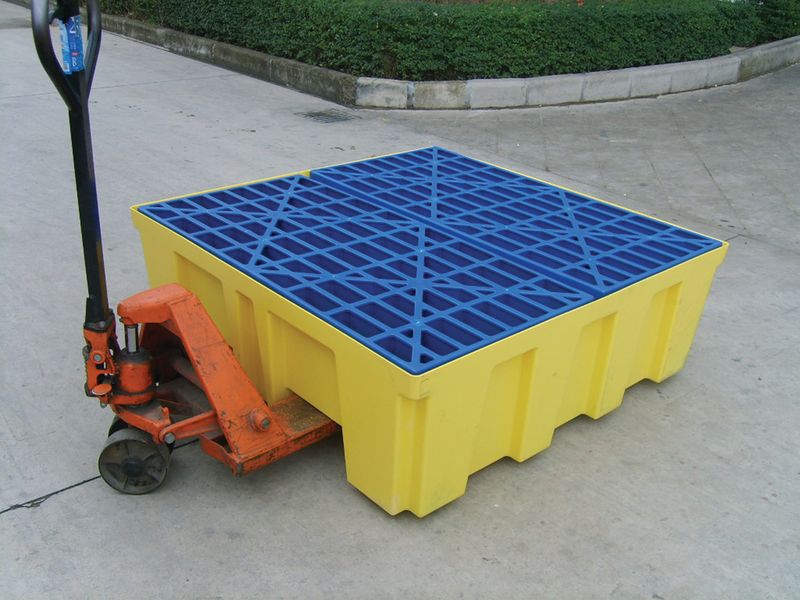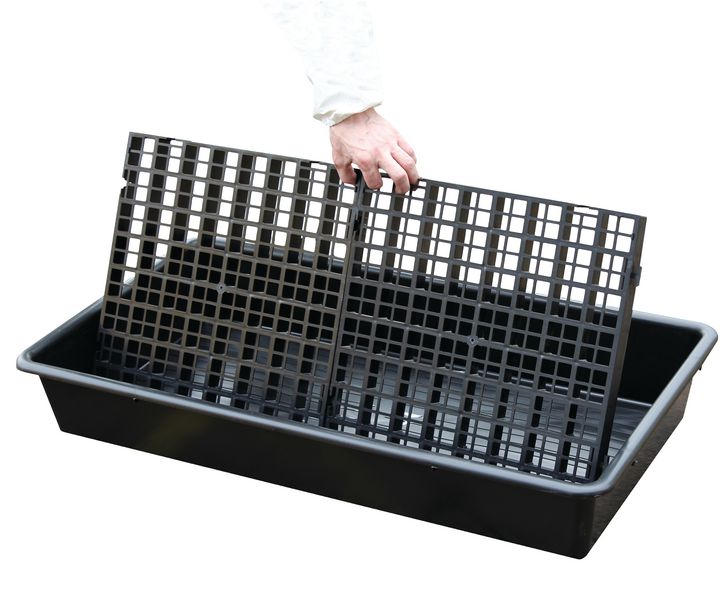-

Spill Deck
£134.99Supplied in: Single kit -

Enpac Spill Pallets
From £260.99 To £382.99Supplied in: Single -

Enpac 2 & 4 Drum Spill Pallets
From £269.99 To £299.99Supplied in: Single -
Promotion

Spill Trays
From £149.99 To £199.99
From £89.99 To £169.99
Supplied in: Single -
Promotion

Economy IBC Sump Pallets
From £999.99 To £1,499.99
From £899.99 To £1,499.99
Supplied in: Single -
Promotion

Romold Spill Trays with Grid
From £51.99 To £89.99
From £44.99 To £84.99
Supplied in: Single -

Romold Spill Tray For 25 Litre Cans
£219.99Supplied in: Single -

Romold Inline Bund Flooring
£469.99Supplied in: Single -
Promotion

Hardcover Spill Pallets
From £1,499.99 To £2,499.99
From £1,499.99 To £2,399.99
Supplied in: Single kit -
Promotion

Galvanised Drip Trays
£69.99
£64.99
Supplied in: Single -
Promotion

Enpac Drum Workstations
From £329.99 To £899.99
From £299.99 To £899.99
Supplied in: Single -

Romold Contained Spill Trays
From £89.99 To £199.99Supplied in: Single -
Promotion

Romold Spill Trays
From £24.99 To £54.99
From £24.99 To £49.99
Supplied in: Single -
Promotion

Galvanised Steel Spill Pallet
From £699.99 To £899.99
From £649.99 To £849.99
Supplied in: Single -
Promotion

Romold Low Profile Spill Trays
From £24.99 To £34.99Supplied in: Single -

Romold Pouring Spill Tray
£16.99Supplied in: Single -
Promotion

Armorgard DrumBank IBC Containter Storage - Grey
£3,999.99
£3,799.99
Supplied in: Single -
Promotion

IBC Galvanised Steel Spill Pallet
From £1,399.99 To £1,699.99
From £1,299.99 To £1,699.99
Supplied in: Single -

Enpac Hardcover Spill Pallet Ramp
£549.99Supplied in: Single -
Promotion

Steel Blue Sump Flooring Chemical-Resistant Materials
From £1,399.99 To £2,999.99Supplied in: Single -
Promotion

Romold Recycled Spill Pallet
From £249.99 To £349.99
From £219.99 To £319.99
Supplied in: Single -
Promotion

Enpac Single Drum Spill Trays
From £159.99 To £249.99
From £129.99 To £199.99
Supplied in: Single -
Promotion

Bunded Steel Spill Flooring
From £1,199.99 To £1,799.99
From £1,099.99 To £1,799.99
Supplied in: Single -
Promotion

Premier IBC Sump Pallet
£2,699.99
£2,499.99
Supplied in: Single kit -
Promotion

Enpac Poly-Lab Tray
£159.99
£139.99
Supplied in: Single -

Sump Flooring - Optional Ramp
£549.99Supplied in: Single
Drum Pallets & Trays
Need help?
 Get your spill pallet & tray questions answered
UK Compliant Drum & IBC Spill Bund Sump Pallets & Trays
Get your spill pallet & tray questions answered
UK Compliant Drum & IBC Spill Bund Sump Pallets & Trays
Do you have a plan in place, if a hazardous substance container begins leaking? Official guidelines recommend the use of secondary containment, such as spill trays and pallets, for all drums, barrels and intermediate bulk containers (IBCs). Storing and moving hazardous substances in this way ensures people, objects and the wider environment are properly protected against spills and leaks.
At Seton we supply bunded and sump pallets to contain spills or leaks, ensuring you stay compliant under COSHH regulations, as well as save you time and money on clean-up in the event of an incident. Order today with fast delivery.

Expert Information
Spill Pallets – Need to Know Information
What is a spill pallet?
A spill pallet or containment pallet is a tray designed to capture and hold liquid safely. Cans, drums and other containers are stored on top of the spill tray, such as the Romold Spill Tray With Grid, so that in the event of a leak or spillage, the liquid will drip into the spill pallet, rather than onto the floor or into the base of a storage unit such as a cabinet. Also known as secondary containment pallets, spill pallets are manufactured from sturdy plastic or metal, and are designed to ensure that liquid that escapes from its original container is held securely and will not spread to other parts of your premises.What is a spill pallet used for?
Spill pallets and bunding trays are designed for use with containers of fuel or chemicals that are harmful or hazardous. Drum spill containment is important to catch and contain any spillages or discharge from drums and other containers. It minimises the risk of damage to other stock or equipment on your premises, as well as preventing harm to staff and visitors, who might inadvertently have contact with hazardous substances. These substances may be toxic or flammable and will cause contamination to the area if left to leak without containment. A bunded pallet such as the Economy IBC Sump Pallet can prevent this.When is a spill pallet required?
If a leak or spill from a drum containing a hazardous substance occurs on your site, the ramifications can be serious and far reaching. Not only is there a risk of injury and damage to premises, but there is also a chance of cross-contamination and environmental pollution. Because of this, there are several strict government rules regarding the storage of drums in the workplace. A large part of this involves preventing accidental discharges from spreading by using spill containment equipment such as sump pallets and drip trays. Relevant regulations include the Control of Major Accidents Hazards 1999 (COMAH) and the Control of Substances Hazardous to Health 2002 (COSHH).When choosing the amount of secondary containment you require, remember to take into account the range of substances you store. Liquids that could potentially be harmful if mixed must not be placed together. A risk assessment will identify which liquids could cause a problem if they were to come into contact. You can then work out how many separate spill storage areas you will need. You can choose from our wide range of spill trays – from drum bund and chemical bund trays for storage to drum spill pallets and other secondary containment pallets that can be used to transport hazardous substances to ensure that any spillages in transit are securely contained.
To be certain that you are meeting your legal requirements, Seton is able to supply a wide range of spill containment items, ranging from small trays suitable for use while working to large sump pallets that can hold several drums at once.
For containers or bottles up to around 25 litres in size, the following spill trays can be used to catch any leaks:
- Galvanised Drip Trays offer a robust solution for catching small quantities of harmful liquids. They are ideal for holding cans and small drums, and can also be positioned beneath machinery to catch small drips of fluid, such as oil.
- The Romold Spill Tray for 25 Litre Cans is a robust option that can hold up to 100 litres in the bunding tray.
For a similar solution for larger containers, there are also several intermediate bulk container spill pallets available. Our IBC range includes IBC storage such as IBC drip trays, IBC bunding, and IBC pallet bunds for handling. The Premier IBC Sump Pallet is manufactured from single-piece polyethylene, which is suitable for use with most chemicals, and has no risk of corrosion. Robust internal columns can safely support the weight of your IBCs, up to a maximum load of 8,000lbs, while grates on the surface minimise the skid risk. This pallet can be lifted with a forklift from either the front or the side.
Whether you need a 2 drum spill pallet or a 4 drum spill pallet, the Enpac 2 & 4 Drum Spill Pallets are just what you need to ensure that you are compliant with health and safety requirements, and to keep your premises free of contamination in the event of a hazardous liquid leak.
Sump provision for larger spaces
If you have a large space that requires secondary containment protection, there are several items that can be used. Spill decks have a low rise and can be easily attached together to create runs of sump provision. This can be particularly useful for areas where chemicals or oil are worked with, as their slim design does not take up as much space. When placed under taps, they make superb drip trays.For larger areas, the following options are ideal:
- Bunded Steel Spill Flooring – this robust drum pallet is seam-welded for extra durability. The removable steel mesh grid means that this spill containment pallet is easy to clean. It is also easy to load, thanks to the low level of the tray.
- Romold Inline Bund Flooring – this can hold up to 300 litres and can be used to store up to four 205-litre drums. Weighing just 42kg, this flooring product can be moved easily thanks to the lightweight polyethylene used in its construction.
- Steel Blue Sump Flooring – coated in anti-corrosive paint, the sump has welded seams to ensure that any liquid that has escaped from the drums above is held securely. It can be supplied in a choice of sizes, which can then be combined to fill any area, providing flexible containment wherever it might be required. Optional handrails and ramps can be supplied for additional safety.
- Enpac Hardcover Spill Pallet Ramp – this features a non-slip ribbed surface and is designed for use with a range of spill pallets, making it easier to load drums onto pallets using a suitable truck. It is robust enough to take weights of 450kg, yet lightweight enough to be easy to move to use with pallets in different parts of your premises.
One of the big perks of a modular system is the ability to prevent leaked materials from mixing, as drums holding one type of liquid can be stored on one section, and those containing something different can be placed on another.
Are you taking the right precautions with your chemicals and storage?
Instantly get to grips with your responsibilities and the law with our easy-to-use What is COSHH? and COSHH Assessment guides.Other steps you can take to optimise the safe storage of chemicals on your premises include displaying suitable signage to alert people to where hazardous substances are being stored. For example, flammable liquids can easily be identified with signs such as our Warning Flammable Liquid Signs. Available in a choice of material, fixing and size; these signs can be used both outdoors and indoors.
Be sure that you have enough absorbent materials in stock to deal with both keeping secondary containment items such as trays and pallets clean and controlling accidental spills.
At Seton, we have all the equipment you need in one place to provide solutions for storing your chemical supplies safely and to meet COSHH requirements. For advice on the best spill trays and containment pallets for your business, contact the team at Seton today.


